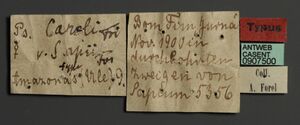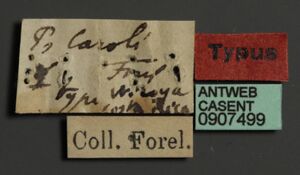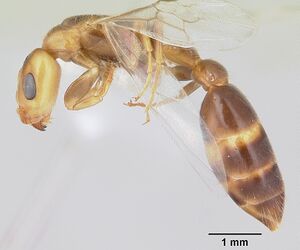Pseudomyrmex viduus
| Pseudomyrmex viduus | |
|---|---|

| |
| Scientific classification | |
| Kingdom: | Animalia |
| Phylum: | Arthropoda |
| Class: | Insecta |
| Order: | Hymenoptera |
| Family: | Formicidae |
| Subfamily: | Pseudomyrmecinae |
| Genus: | Pseudomyrmex |
| Species: | P. viduus |
| Binomial name | |
| Pseudomyrmex viduus (Smith, F., 1858) | |
| Synonyms | |
| |
Nest in the living plant cavities of a wide range of plant species.
| At a Glance | • Ant-plant specialist |
Identification
Ward (1999) - P. viduus is readily distinguished from all other species in the P. viduus group, except Pseudomyrmex vitabilis, by the elongate head (worker CI 0.70–0.79, queen CI 0.60–0.67, male CI 0.86–0.94). Other characteristic features are the closely contiguous frontal carinae (worker MFC < 0.080, queen MFC 0.054–0.090), long eyes relative to head width (worker REL2 > 0.49, queen REL2 0.56–0.61), flattened worker mesosoma, and broad profemur (both worker and queen FI 0.44–0.49). See P. vitabilis for differences from viduus.
Distribution
Latitudinal Distribution Pattern
Latitudinal Range: 19.46638889° to -5.673056°.
| North Temperate |
North Subtropical |
Tropical | South Subtropical |
South Temperate |
- Source: AntMaps
Distribution based on Regional Taxon Lists
Neotropical Region: Bolivia, Brazil (type locality), Colombia, Costa Rica, Cuba, Ecuador, French Guiana, Greater Antilles, Guyana, Honduras, Mexico, Suriname, Trinidad and Tobago.
Distribution based on AntMaps
Distribution based on AntWeb specimens
Check data from AntWeb
Countries Occupied
| Number of countries occupied by this species based on AntWiki Regional Taxon Lists. In general, fewer countries occupied indicates a narrower range, while more countries indicates a more widespread species. |

|
Estimated Abundance
| Relative abundance based on number of AntMaps records per species (this species within the purple bar). Fewer records (to the left) indicates a less abundant/encountered species while more records (to the right) indicates more abundant/encountered species. |

|
Biology
Ward (1999) - The least host-specific of the species inhabiting living plant cavities: colonies have been collected from Cordia alliodora (Ruiz & Pavon) Oken (Costa Rica), Coussapoa (Brazil), Ficus (?) branches (Colombia, Peru), Macrolobium acaciifolium (Bentham) Bentham (Ecuador), Ocotea (Costa Rica, Peru), Pseudobombax munguba (Martius & Zuccarini) Dugand (Brazil, Colombia), Pseudobombax cf. septenatum ( Jacquin) Dugand (Colombia), Pterocarpus amazonum (C. Martius ex Bentham) Amshoff (Colombia), Sapium (Brazil, Ecuador), Triplaris melaenodendron (Bertoloni) Standley & Steyermark (Costa Rica), Triplaris weigeltiana (Venezuela, Guyana), unidentified species of Triplaris (Colombia, Venezuela), and hollow stems of an unidentified Papilionoideae (Guyana). There is even a record of a colony-founding queen from Cecropia (Peru). In his study of ant-plant associations in Costa Rica, Longino (1996) noted that both Pseudomyrmex viduus and Azteca beltii Emery had exceptionally broad host ranges compared to most other plant-ants.
Earlier literature dealing with P. viduus includes Wheeler’s (1942) and Bailey’s (in Wheeler, 1942:51–52) fascinating observations on this species in Guyana (under the name P. triplaridis baileyi). They reported it to be a fierce, aggressive ant, occupying the internodes of Triplaris weigeltiana (= T. surinamensis) branches and cohabiting with the pseudococcid Farinococcus multispinosus Morrison and the coccid Cryptostigma inquilina (Newstead) (cited as Akermes secretus Morrison), in addition to nematodes and fungi that fed on the ant middens. Bailey’s examination of the food pellets of P. viduus larvae revealed not only the remains of coccoids but also those of fungal hyphae and nematodes.
In my experience the nests of this species always contain pseudococcids or coccids. In a recent collection of P. viduus from live branches of Sapium utile (7 km ESE Pto. Misahualli, Ecuador; P. S. Ward#11320) the coccids were identified as belonging to the genus Cryptostigma (plant identification by G. Webster, coccids by P. J. Gullan).
Castes
Worker
Images from AntWeb
   
| |
| Syntype of Pseudomyrma ulei. Worker. Specimen code casent0907567. Photographer Z. Lieberman, uploaded by California Academy of Sciences. | Owned by MHNG, Geneva, Switzerland. |
   
| |
| Syntype of Pseudomyrma caroli sapii. Worker. Specimen code casent0907500. Photographer Z. Lieberman, uploaded by California Academy of Sciences. | Owned by MHNG, Geneva, Switzerland. |
   
| |
| Worker. Specimen code casent0217584. Photographer Will Ericson, uploaded by California Academy of Sciences. | Owned by CAS, San Francisco, CA, USA. |
   
| |
| Syntype of Pseudomyrma triplaridis tigrina. Worker. Specimen code casent0902881. Photographer Z. Lieberman, uploaded by California Academy of Sciences. | Owned by NHMUK, London, UK. |
   
| |
| Syntype of Pseudomyrma caroli. Worker. Specimen code casent0907499. Photographer Z. Lieberman, uploaded by California Academy of Sciences. | Owned by MHNG, Geneva, Switzerland. |
Queen
Images from AntWeb
   
| |
| Queen (alate/dealate). Specimen code casent0178711. Photographer April Nobile, uploaded by California Academy of Sciences. | Owned by MIZA, Maracay, Venezuela. |
   
| |
| Specimen code casent0902880. . | |
Nomenclature
The following information is derived from Barry Bolton's Online Catalogue of the Ants of the World.
- viduus. Pseudomyrma vidua Smith, F. 1858b: 158 (m.) BRAZIL. Combination in Pseudomyrmex: Kusnezov, 1964: 83. Senior synonym of baileyi (and its junior synonym biolleyi), caroli, sapii, tigrina (and its junior synonym trigona), ulei: Ward, 1989: 445; of opacior: Ward, 1999b: 510.
- caroli. Pseudomyrma caroli Forel, 1899c: 89 (w.q.) COSTA RICA. Wheeler, G.C. & Wheeler, J. 1956: 382 (l.). Combination in Pseudomyrmex: Wheeler, G.C. & Wheeler, J. 1956: 382. Junior synonym of viduus: Ward, 1989: 445.
- opacior. Pseudomyrma latinoda var. opacior Forel, 1904d: 170 (w.) CUBA. Combination in Pseudomyrmex: Kempf, 1961a: 400. Subspecies of latinoda: Wheeler, W.M. 1942: 169. Raised to species: Ward, 1990: 485. Junior synonym of viduus: Ward, 1999b: 510.
- sapii. Pseudomyrma caroli var. sapii Forel, 1904e: 688 (w.q.) BRAZIL. Combination in Pseudomyrmex: Kempf, 1961a: 400. Junior synonym of viduus: Ward, 1989: 445.
- ulei. Pseudomyrma ulei Forel, 1904e: 689 (w.q.m.) BRAZIL. Combination in Pseudomyrmex: Kempf, 1961a: 401. Junior synonym of viduus: Ward, 1989: 445.
- baileyi. Pseudomyrma triplaridis subsp. baileyi Wheeler, W.M. 1942: 185, pl. 50 (w.q.) GUYANA. Combination in Pseudomyrmex: Kempf, 1961a: 400. Senior synonym of biolleyi: Brown, 1949a: 43. Junior synonym of viduus: Ward, 1989: 445.
- tigrina. Pseudomyrma triplaridis subsp. tigrina Wheeler, W.M. 1942: 186 (w.m.) GUYANA. Combination in Pseudomyrmex: Kempf, 1961a: 400. Senior synonym of trigona: Brown, 1949a: 43. Junior synonym of viduus: Ward, 1989: 445.
- biolleyi. Pseudomyrma triplaridis subsp. biolleyi Enzmann, E.V. 1944: 93 (w.) GUYANA. Junior synonym of baileyi: Brown, 1949a: 43.
- trigona. Pseudomyrma triplaridis subsp. trigona Enzmann, E.V. 1944: 94 (w.) GUYANA. Junior synonym of tigrina: Brown, 1949a: 43.
Unless otherwise noted the text for the remainder of this section is reported from the publication that includes the original description.
Description
Worker
Ward (1999) - Measurements (n=35). HL 0.94–1.30, HW 0.74–0.97, MFC 0.047–0.079, LHT 0.63–0.88, CI 0.70–0.79, REL 0.39–0.44, REL2 0.50–0.57, FCI 0.05–0.09, SI 0.44–0.50, FLI 1.27–1.67, FI 0.44–0.49, PLI 0.75–0.92, PWI 0.73–0.92, PPWI 1.31–1.70.
Relatively small species (HW <1.00). Masticatory margin of mandible with 6 (rarely 5 or 7) teeth. Palp formula 5,3. Median clypeal lobe anterolaterally rounded (not sharply angulate), its anteromedial surface deflected ventrally. Frontal carinae less well separated than in most species of the P. viduus group (MFC <0.080, PFC <0.120), tending be parallel or slightly converging along most of their course and then more strongly converging posteriorly (ASM ≥ PFC > MFC). Median lobes of antennal sclerites relatively well exposed (PFC/ASD 0.52–0.64; FCI2 0.31–0.53). Scape expanded distally to twice its basal width; funiculus short, also expanded apically, the terminal segment about 1.4–1.6 times the width of the first segment; funicular segment 2 about as broad as, or broader than, long; funicular segments 3–10 notably broader than long. Head elongate (CI < 0.80), the sides relatively straight, usually diverging slightly posteriorly; side of head rounding relatively gradually into the posterior margin, which is concave in frontal view. Mesosoma dorsum more or less flattened, metanotal groove moderately incised (MP 0.034–0.077); dorsal face of propodeum somewhat longer than the declivitous face (PDI 1.01–1.51), and meeting the latter at a well rounded angle. Metapleural gland bulla well-developed and conspicuous. Profemur broad (FI > 0.43) and legs relatively short, LHT/HL 0.63–0.71. Petiole slightly longer than high (PLI < 0.93), with a weakly differentiated anterior peduncle, followed by an increasingly convex anterodorsal face which rounds into the posterior face; posterior face appearing only slightly steeper than anterior face (lateral view). Summit of node behind the midpoint of the petiole (NI 0.51–0.63). Anteroventral petiolar process usually well developed, variable in shape, subtriangular, bluntly rounded, or fin-shaped, directed ventrally or posteroventrally. In dorsal view, the minimum (anterior) width of petiole about half the maximum width (PWI3 0.44–0.56). Postpetiole notably broader than long (PPWI >1.30); ventral protrusion of postpetiolar sternite prominent and anteroventral process of postpetiole moderately well developed. Mandible generally sublucid, with scattered elongate punctures and overlying fine striolation. Sculpture on dorsum of head somewhat variable, punctures on the anterior half to two thirds of head relatively dense, evenly spaced, mostly 0.010–0.020mm in diameter, and separated by about their diameters or less; punctures on upper third of head less dense and more unevenly spaced, separated by several to many diameters, the interspaces either smooth and shiny or very weakly coriarious. Mesosoma dorsum sublucid, with numerous piligerous punctures (separated by one to several diameters); side of mesosoma with sculpture less uniform, with a tendency towards the development of more extensive smooth shiny or weakly coriarious interspaces on parts of the mesopleuron which contrasts with coarser imbricate-punctulate and imbricate-costulate sculpture adjacent to this on the posterior margin of the mesopleuron, on the metapleuron and on the lateral propodeum. Petiole, postpetiole and gaster sublucid, the reflectance dulled (especially on the gaster) by fine punctulae and associated appressed pubescence. Standing pilosity common (MSC 45–88, HTC 8–18); standing and decumbent hairs conspicuous on the posterior margin of head (frontal view) but absent or sparse along the sides. Appressed pubescence well developed, most conspicuous on the mesosoma, petiole (sparse medially in some individuals), postpetiole and gaster; postpetiole and abdominal tergite IV with appressed hairs separated by much less than their lengths. Body generally concolorous medium- to dark-brown, although in some populations the gaster is darker than rest of body; antennae, frontoclypeal complex, side of head, and distal portions of legs tending to be lighter yellow- or orange-brown in colour.
Type Material
Ward (1999):
- Syntype male (unique), Ega, Amazonas, Brazil (The Natural History Museum) [Examined].
- Pseudomyrma caroli Forel, 1899:89. Syntype workers, queens, Nicoya, Costa Rica (Alfaro) (Museo Civico di Storia Naturale, Genoa, Musee d'Histoire Naturelle Genève) [Examined].
- Pseudomyrma latinoda var. opacior Forel, 1904b:170. Holotype worker, Cuba (“coll. Ballion, ex-coll. Puls”), apparently lost, not in Royal Belgian Institute of Natural Sciences nor Laboratoria voor Morfologie en Systematiek, Museum voor Dierkunde, Gent, Belgium (P. Dessart, pers. comm.).
- Pseudomyrma caroli var. sapii Forel, 1904c:688. Syntype workers, queens, Bom Fim, Jurua, Amazonas, Brazil (Ule) (American Museum of Natural History, MCSN, MHNG) [Examined].
- Pseudomyrma ulei Forel, 1904c:689. Syntype workers, Jurua Miry, Jurua, Amazonas, Brazil (Ule) (AMNH, MCSN, MHNG, Naturhistorisches Museum, Basel) [Examined].
- Pseudomyrma triplaridis subsp. baileyi Wheeler, 1942:185. Syntype workers, queens, Camaria, Cuyuni River, Guyana (MCZC, National Museum of Natural History) [Examined].
- Pseudomyrma triplaridis subsp. tigrina Wheeler, 1942:186. Lectotype worker, Blairmont, Berbice, Guyana (Museum of Comparative Zoology) [Examined].
- Pseudomyrma triplaridis subsp. biolleyi Enzmann, 1944:93. Syntype workers, queens, Camaria Cuyuni River, Guyana (MCZC) [Examined].
- Pseudomyrma triplaridis subsp. trigona Enzmann, 1944:94. Syntype workers, males, Blairmont, Berbice, Guyana (MCZC) [Examined].
References
- Franco, W., Ladino, N., Delabie, J.H.C., Dejean, A., Orivel, J., Fichaux, M., Groc, S., Leponce, M., Feitosa, R.M. 2019. First checklist of the ants (Hymenoptera: Formicidae) of French Guiana. Zootaxa 4674, 509–543 (doi:10.11646/zootaxa.4674.5.2).
- Kusnezov, N. 1964 [1963]. Zoogeografía de las hormigas en Sudamérica. Acta Zool. Lilloana 19: 25-186 (page 83, Combination in Pseudomyrmex)
- Smith, F. 1858b. Catalogue of hymenopterous insects in the collection of the British Museum. Part VI. Formicidae. London: British Museum, 216 pp. (page 158, male described)
- Ward, P. S. 1989a. Systematic studies on pseudomyrmecine ants: revision of the Pseudomyrmex oculatus and P. subtilissimus species groups, with taxonomic comments on other species. Quaest. Entomol. 25: 393-468 (page 445, Senior synonym of baileyi (and its junior synonym biolleyi), caroli, sapii, tigrina (and its junior synonym trigona) and ulei)
- Ward, P. S. 1999b. Systematics, biogeography and host plant associations of the Pseudomyrmex viduus group (Hymenoptera: Formicidae), Triplaris- and Tachigali-inhabiting ants. Zool. J. Linn. Soc. 126: 451-540 (page 510, Senior synonym of opacior)
- Ward, P.S., Downie, D.A. 2005. The ant subfamily Pseudomyrmecinae (Hymenoptera: Formicidae): phylogeny and evolution of big-eyed arboreal ants. Systematic Entomology 30:310-335 (doi:10.1111/j.1365-3113.2004.00281.x).
References based on Global Ant Biodiversity Informatics
- Adams B. J., S. A. Schnitzer, and S. P. Yanoviak. 2016. Trees as islands: canopy ant species richness increases with the size of liana-free trees in a Neotropical forest. Ecography doi: 10.1111/ecog.02608
- Adams B. J., S. A. Schnitzer, and S. P. Yanoviak. 2019. Connectivity explains local ant community structure in a Neotropical forest canopy: a large-scale experimental approach. Ecology 100(6): e02673.
- Alayo D. P. 1974. Introduccion al estudio de los Himenopteros de Cuba. Superfamilia Formicoidea. Academia de Ciencias de Cuba. Instituto de Zoologia. Serie Biologica no.53: 58 pp. La Habana.
- Baroni Urbani C. 1977. Katalog der Typen von Formicidae (Hymenoptera) der Sammlung des Naturhistorischen Museums Basel (2. Teil). Mitt. Entomol. Ges. Basel (n.s.) 27: 61-102.
- Brandao, C.R.F. 1991. Adendos ao catalogo abreviado das formigas da regiao neotropical (Hymenoptera: Formicidae). Rev. Bras. Entomol. 35: 319-412.
- Dattilo W. et al. 2019. MEXICO ANTS: incidence and abundance along the Nearctic-Neotropical interface. Ecology https://doi.org/10.1002/ecy.2944
- Del Toro, I., M. Vázquez, W.P. Mackay, P. Rojas and R. Zapata-Mata. Hormigas (Hymenoptera: Formicidae) de Tabasco: explorando la diversidad de la mirmecofauna en las selvas tropicales de baja altitud. Dugesiana 16(1):1-14.
- Enzmann E. V. 1944. Systematic notes on the genus Pseudomyrma. Psyche (Camb.) 51: 59-103.
- Fernández F., and E. E. Palacio. 1995. Hormigas de Colombia IV: nuevos registros de géneros y especies. Caldasia 17: 587-596.
- Fernández, F. and S. Sendoya. 2004. Lista de las hormigas neotropicales. Biota Colombiana Volume 5, Number 1.
- Fontanla Rizo J.L. 1997. Lista preliminar de las hormigas de Cuba. Cocuyo 6: 18-21.
- Fontenla J. L., and J. Alfonso-Simonetti. 2018. Classification of Cuban ants (Hymenoptera: Formicidae) into functional groups. Poeyana Revista Cubana de Zoologia 506: 21-30.
- Fontenla Rizo J. L. 1997. Lista preliminar de las hormigas de Cuba (Hymenoptera: Formicidae). Cocuyo 6: 18-21.
- Forel A. 1904. Fourmis du Musée de Bruxelles. Ann. Soc. Entomol. Belg. 48: 168-177.
- Forel A. 1912. Einige interessante Ameisen des Deutschen Entomologischen Museums zu Berlin-Dahlem. Entomol. Mitt. 1: 81-83.
- Franco W., N. Ladino, J. H. C. Delabie, A. Dejean, J. Orivel, M. Fichaux, S. Groc, M. Leponce, and R. M. Feitosa. 2019. First checklist of the ants (Hymenoptera: Formicidae) of French Guiana. Zootaxa 4674(5): 509-543.
- INBio Collection (via Gbif)
- Kempf, W.W. 1972. Catalago abreviado das formigas da regiao Neotropical (Hym. Formicidae) Studia Entomologica 15(1-4).
- Longino J. et al. ADMAC project. Accessed on March 24th 2017 at https://sites.google.com/site/admacsite/
- Mann W. M. 1922. Ants from Honduras and Guatemala. Proceedings of the United States National Museum 61: 1-54.
- Portuondo Ferrer E., and J. L. Fernández Triana. 2005. Species of hymenopterans (bees, wasps, and ants) recorded in Alejandro de Humboldt National Park, from literature records, revision of the collection at BIOECO, and collections before and during the rapid inventory, 12-22 February 2004. In Fong G., A., D. Maceira F., W. S. Alverson, y/and T. Wachter, eds. 2005. Cuba: Parque Nacional Alejandro de Humboldt. Rapid Biological Inventories Report 14. The Field Museum, Chicago.
- Vásquez-Bolaños M. 2011. Lista de especies de hormigas (Hymenoptera: Formicidae) para México. Dugesiana 18: 95-133
- Ward P. S. 1990. The Ant Subfamily Pseudomyrmecinae (Hymenoptera: Formicidae): Generic Revision and Relationship to Other Formicids. Systematic Entomology 15: 449-489
- Ward P. S. 1992. Ants of the genus Pseudomyrmex (Hymenoptera: Formicidae) from Dominican amber, with a synopsis of the extant Antillean species. Psyche (Cambridge) 99: 55-85
- Ward P. S. 1999. Systematics, biogeography and host plant associations of the Pseudomyrmex viduus group (Hymenoptera: Formicidae), Triplaris- and Tachigali-inhabiting ants. Zoological Journal of the Linnean Society 126: 451-540
- Ward, P. S. 1989. Systematic Studies on Pseudomyrmecine Ants: Revision of the Pseudomyrmex Oculatus and P. Subtilissimus Species Groups with Taxonomic Comments on Other Species. Questiones Entomologicae 25: 393-468
- Wheeler W. M. 1907. A collection of ants from British Honduras. Bulletin of the American Museum of Natural History 23: 271-277.
- Wheeler W. M. 1913. The ants of Cuba. Bulletin of the Museum of Comparative Zoology 54: 477-505.
- Wheeler W. M. 1942. Studies of Neotropical ant-plants and their ants. Bulletin of the Museum of Comparative Zoology 90: 1-262.

